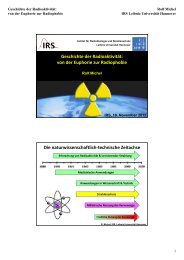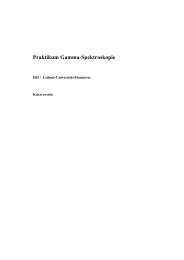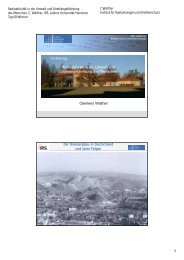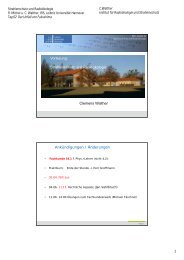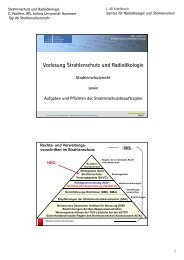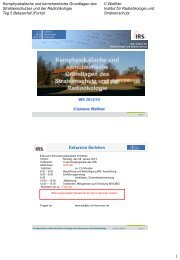Erfolgreiche ePaper selbst erstellen
Machen Sie aus Ihren PDF Publikationen ein blätterbares Flipbook mit unserer einzigartigen Google optimierten e-Paper Software.
260 GLOSSAR<br />
Emittanz, spektrale Brilliance, spectral. Measure of power/area (intensity) per unit wavelength (or<br />
frequency) of light. Defined ambiguosly in literature. Often also power per (unit area x unit<br />
wavelength x unit solid emission angle). (Eq. (1.0)) [p. 11]<br />
Entartung Degeneration. Number of substates with equal energie. One example are the magnetic<br />
substates in absence of an external magnetic field and without (hyper)fineinteraction.<br />
(Eq. (2.31)) [p. 21]<br />
Entartungsparameter Degeneration parameter. Population number of one Eigenmode.<br />
(Eq. (2.33)) [p. 22]<br />
Exzimer Excimer. Molecule that is stable only in its excited states. The groundstate does not exist.<br />
Exploited for Excimer-Lasers by generating the excimers by electron impact. Population<br />
inversion is achieved intrinsicly, since the molecule is unstable after photon-emission. Excimerlasers<br />
are two level lasers. (Eq. (1.0)) [p. 7]<br />
Franck-Condon Prinzip The Frank-Condon principle states that electronic transitions take place in<br />
times that are very short compared to the time required for the nuclei to move significantly.<br />
Hence, the geometry does not change immediately upon an electric transition between two<br />
electronic states. If, in the case of absorption, the excited stae needs a larger atomic distance<br />
of the nuclei inside a molecule than the ground state, the transition is strongly hindered due<br />
to low F.C. factors. In order for fluorescence to occur, the photoemission probability must be<br />
quite large, so only transitions of the same spin are allowed. For example, if the ground state<br />
is S0, then the fluorescing state would be S1. (Eq. (4.18)) [p. 96]<br />
Gruppengeschwindigkeits Dispersion group velocity dispersion (GVD). A fs-laser pulse contains<br />
light of a broad spectral range. In a normal dispersive medium the refractive index of blue<br />
light exceeds the one of red light and hence the red fraction of the pulse travels faster than<br />
the blue. This leads to a temporal broadening of the light pulse. (Eq. (4.58)) [p. 134]<br />
GVD siehe Gruppengeschwindigkeits Dispersion (Eq. (4.58)) [p. 134]<br />
Güteschaltung Q-switch A ’shutter’ placed between the amplifying rod and the end mirrors of a<br />
laser can prevent laser action as long as it is closed. If conditions are otherwise correct for<br />
laser action and the shutter is suddenly opened, the stored energy is released as a giant pulse<br />
of light lasting only a few nanoseconds and having a peak power capacity that may be as<br />
high as several hundred megawatts. This is known as Q-switching. The Q-switch may be a<br />
mechanical shutter or, more usually, a liquid or solid optical shutter that is normally opaque<br />
but can be made transparent by the application of an electrical pulse. The shutter may also<br />
be an opaque dye which becomes transparent when exposed to laser light. (Eq. (1.0)) [p. 7]<br />
Huygenschen Elementarwellen Huygens’ theorem. Huygens used for the description of light within<br />
the framework of wave propagation, the picture that a wavefront can be described as an infinite<br />
number of secondary spherical wavelets which evenate from every point of the wavefront.<br />
The position of the wavefront at any later time is the envelope of all such wavelets. If some<br />
parts of the wavefront are blocked, e.g. by a slit, the passing waves interfere and the typical<br />
refraction patterns caused by an optical slit experiment are described by integration of all<br />
spherical waves. (Eq. (2.67)) [p. 36]



